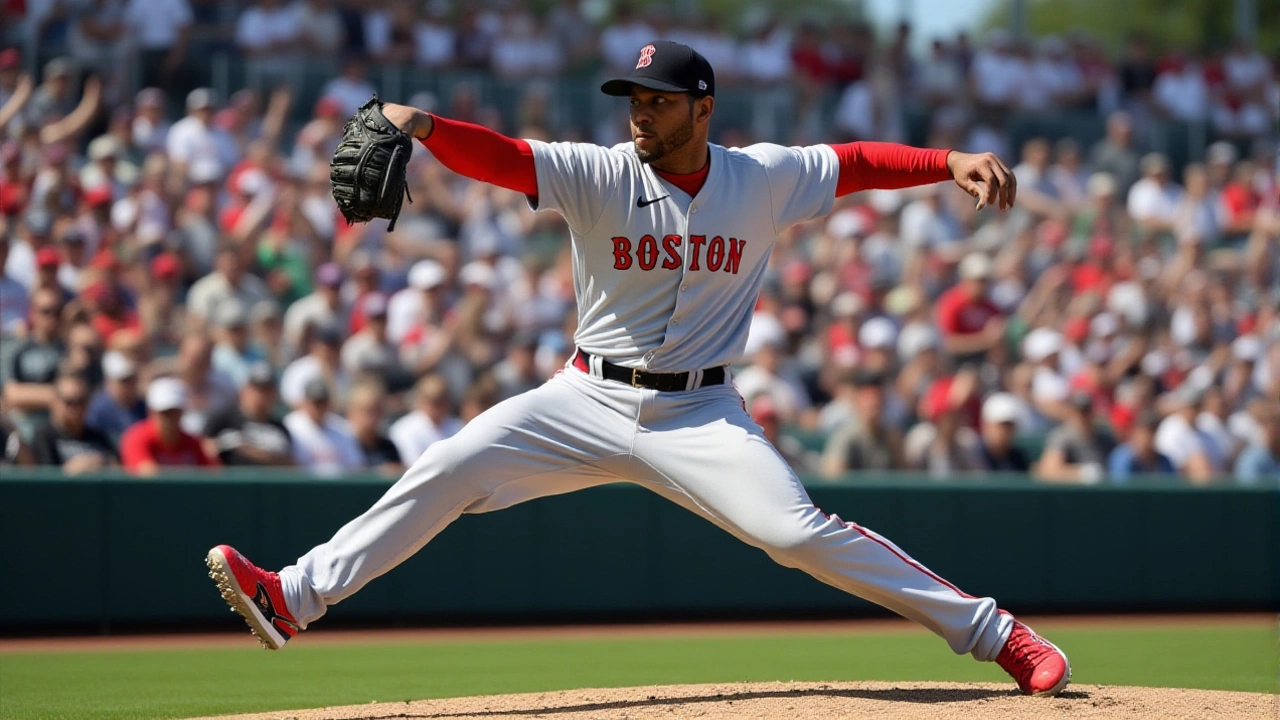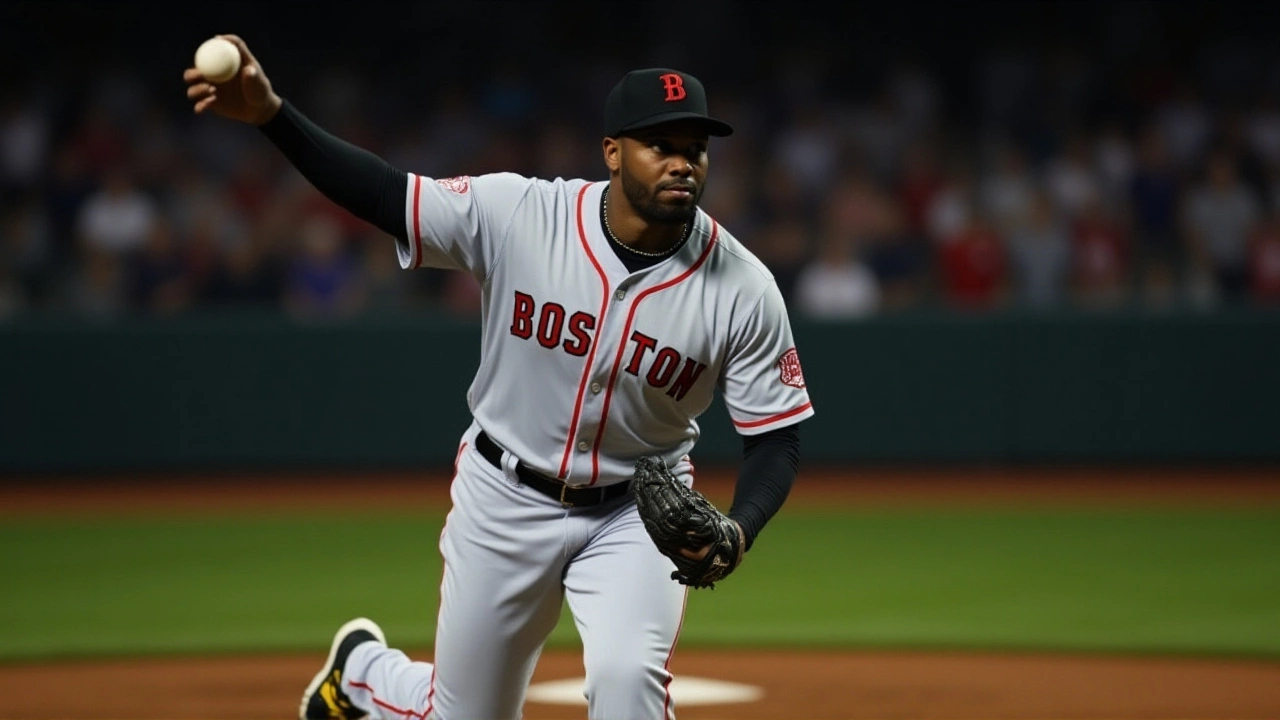When Aroldis Chapman, the 37‑year‑old left‑handed closer known as the “Cuban Missile,” agreed to a new deal, the Boston Red Sox secured one of baseball’s most feared relievers through the 2026 season, with a mutual option for 2027.
The extension was unveiled on September 1, 2025, just days after Chapman posted a jaw‑dropping 1.04 ERA over 52 innings. That performance, recorded at Fenway Park, placed him atop the league’s qualified relievers and gave the Red Sox a lightning‑fast back‑stop as they chase the AL East crown.
How Chapman’s Boston comeback rewrote his career narrative
Chapman’s 2025 numbers read like a textbook case of resurgence: 26 saves, 74 strikeouts, and a WHIP of 0.88 across 57 appearances. He entered the season on a one‑year, $10.75 million contract signed in December 2024, a gamble many pundits labeled a “high‑risk, high‑reward” move. The gamble paid off, and the new extension reflects that confidence.
Financially, the deal includes a $1 million signing bonus, a $12 million salary for 2026—a $3.5 million bump from his 2025 guarantee—and a 2027 mutual option worth $13 million with a $300,000 buyout. If Chapman meets the performance trigger—at least 40 innings pitched in 2026 and a clean post‑season physical—the option vests, potentially pushing total earnings to $26 million over the two‑year window.
“We’ve seen the kind of impact Aroldis can have in high‑leverage situations,” said Brian O'Halloran, Red Sox Director of Baseball Operations. “Locking him in protects the bullpen’s identity and gives our rotation the peace of mind that the last three outs are in elite hands.”
From Yankees drama to Fenway dominance: a brief road map
Chapman’s path to Boston was anything but smooth. After an acrimonious exit from the New York Yankees in 2022—where a tattoo‑related infection sidelined him and a missed team workout led to his omission from the postseason roster—he bounced to the Kansas City Royals (2.45 ERA) and then to the Texas Rangers, contributing to their World Series run with a 3.72 ERA after the July trade deadline.
His next stop was a one‑year, $5 million pact with the Pittsburgh Pirates in January 2024. That contract was widely viewed as a “prove‑it” deal, and Boston’s December 2024 acquisition turned that proof into a showcase.
Now, with 361 career saves—ranking 13th all‑time—Chapman adds a second World Series ring (2018 with the Boston Red Sox, 2023 with the Rangers) to his résumé, underscoring a late‑career renaissance that few expected.
Rival reactions: Yankees, fans, and the broader MLB community
The acquisition didn’t just ripple through Boston’s clubhouse; it sent a clear signal to longtime rivals. Yankees general manager Brian Cashman reportedly “smiled” when the deal was announced, having anticipated the veteran’s decline. “We thought it would be a footnote for him in Boston,” Cashman told reporters after a Yankees‑Red Sox spring training game, “but his performance proved us wrong.”
Fans on Reddit’s r/RedSox and r/Yankees threads were split. Red Sox supporters celebrated the “psychological edge” of having a closer that can shut down any inning, while a vocal contingent of Yankees fans scoffed at the notion that Chapman’s age would diminish his velocity.
Baseball analysts echoed the sentiment. ESPN’s senior baseball writer John Schneider noted, “He’s still throwing fastballs in the upper 90s. If he stays healthy, the Red Sox have arguably the best back‑end of any AL club.”

Financial nuances and the market’s view of veteran closers
Chapman’s contract is noteworthy amid a market that has softened on aging relievers. In 2024, the average one‑year deal for a closer over 35 was roughly $4 million, according to Spotrac. By locking him in for $13.3 million guaranteed (plus the potential $13 million option), the Red Sox are betting on performance over age.
The structure also reflects modern MLB’s emphasis on incentive‑based clauses. The 40‑inning trigger for 2027 mirrors similar language seen in the 2022 extension for Josh Hader of the Milwaukee Brewers, but Chapman’s buyout is substantially lower, indicating Boston’s confidence in his durability.
Salary‑cap analysts at The Athletic project that the Red Sox’s luxury‑tax calculations will stay comfortably under the 2026 threshold, thanks largely to the contract’s front‑loaded nature.
What’s next for Chapman and the Red Sox bullpen?
Looking ahead to the 2026 season, the biggest question is workload. If Chapman can stay above the 40‑inning mark and maintain his sub‑1.10 ERA, the mutual option will likely vest, cementing a multi‑year alliance that could keep Boston in the playoff hunt through 2027.
Meanwhile, the Red Sox are grooming younger arms—namely Luis Patino and Matt Mahoney—to eventually inherit the closing role. Chapman’s mentorship could accelerate their development, creating a pipeline that extends beyond his own contract.
Should an injury arise, the $300,000 buyout provides Boston an easy exit, but the club’s broader strategy suggests they see Chapman as the centerpiece of a bullpen that can rival any in the AL East. For now, the narrative is clear: Boston bet on a veteran, and that bet paid off spectacularly.
Frequently Asked Questions
How does this extension affect the Red Sox bullpen?
Securing Chapman through 2026 guarantees the Sox a proven back‑end for high‑leverage situations, allowing the team to focus on developing younger relievers without the pressure of finding a new closer. The stability also lets the rotation manager plan games with confidence that the last three outs are in elite hands.
What triggers the 2027 mutual option?
Chapman must log at least 40 innings in the 2026 season and pass a post‑season physical. If both conditions are met, the option becomes fully guaranteed at $13 million; otherwise, the Red Sox can buy out the option for $300,000.
Why did the Yankees release Chapman in 2022?
Chapman missed a mandatory team workout after a tattoo‑related infection, leading to disciplinary action and his exclusion from the Yankees’ postseason roster. The incident, combined with a 4.46 ERA that year, persuaded the club to move on.
How does Chapman’s salary compare to other veteran closers?
At $12 million for 2026, Chapman ranks among the top‑paid closers under 40, exceeding the 2024 average of $4 million for similar‑aged relievers. The deal reflects his elite performance rather than his age, a trend seen in a few other high‑impact veterans.
What does this mean for the Red Sox‑Yankees rivalry?
Having a dominant closer like Chapman gives Boston a late‑game edge that the Yankees historically lacked. It adds another layer to the rivalry, especially since the Yankees originally expected Chapman to decline after his stint with Boston.

Written by Gareth O'Dell
View all posts by: Gareth O'Dell